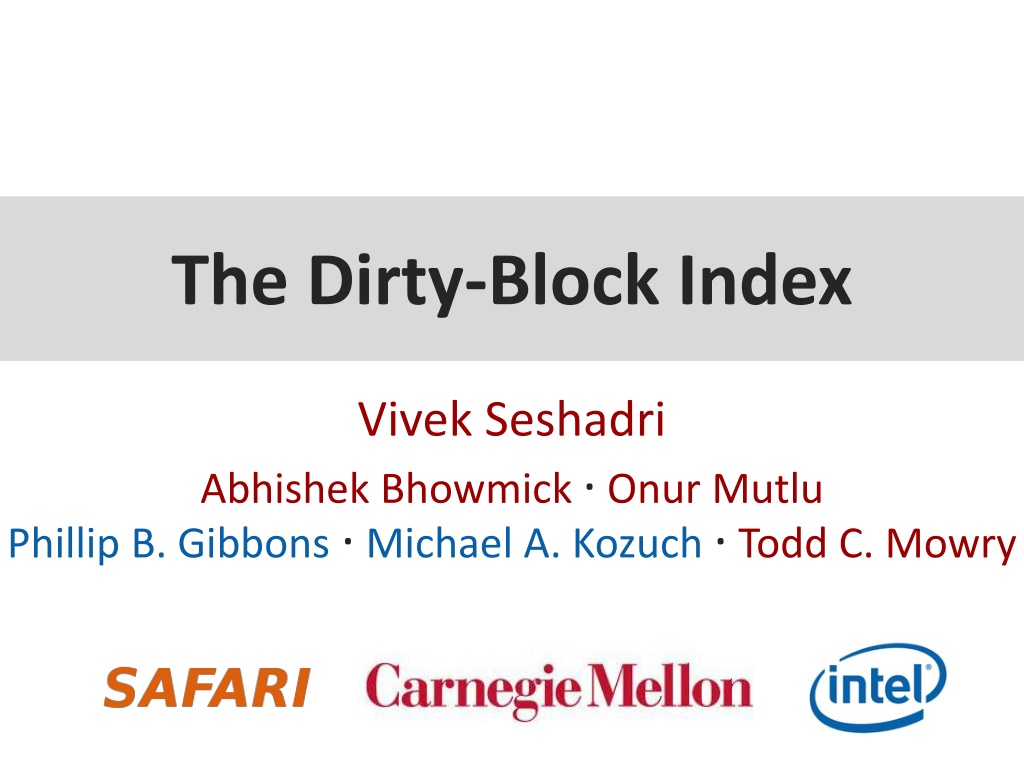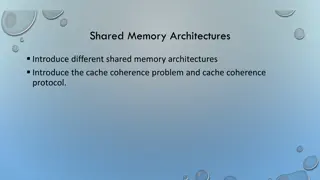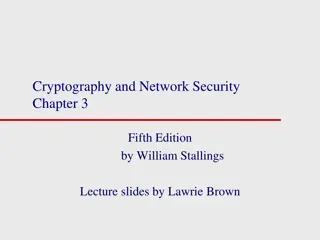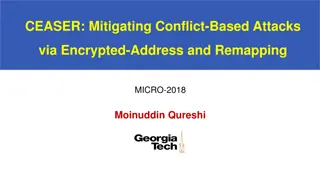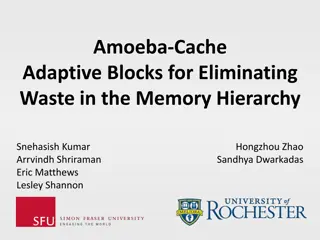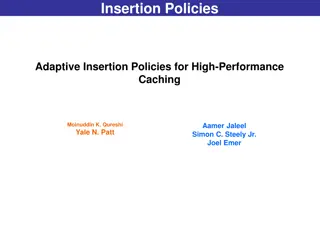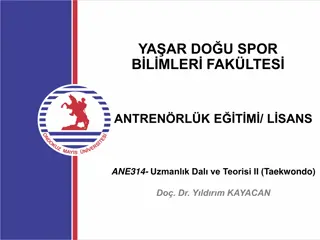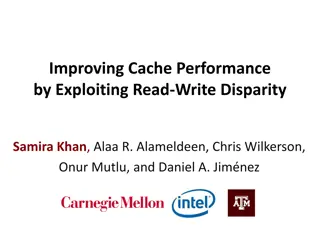Efficient Cache Management using The Dirty-Block Index
The Dirty-Block Index (DBI) is a solution to address inefficiencies in caches by removing dirty bits from cache tag stores, improving query response efficiency, and enabling various optimizations like DRAM-aware writeback. Its implementation leads to significant performance gains and cache area reduction compared to baseline and state-of-the-art approaches.
Download Presentation

Please find below an Image/Link to download the presentation.
The content on the website is provided AS IS for your information and personal use only. It may not be sold, licensed, or shared on other websites without obtaining consent from the author. Download presentation by click this link. If you encounter any issues during the download, it is possible that the publisher has removed the file from their server.
E N D
Presentation Transcript
The Dirty-Block Index Vivek Seshadri Abhishek Bhowmick Onur Mutlu Phillip B. Gibbons Michael A. Kozuch Todd C. Mowry
Summary Problem: Dirty bit organization in caches does not match queries Inefficiency and performance loss The Dirty-Block Index (DBI) Remove dirty bits from cache tag store DRAM row-oriented organization of dirty bits Efficiently respond to queries Get all dirty blocks of a DRAM row; Is block B dirty? Enables efficient implementation of many optimizations DRAM-aware writeback, bypassing cache lookup, reducing ECC cost, Improves performance while reducing overall cache area 28% performance over baseline, 6% over state-of-the-art (8-core) 8% cache area reduction 2 The Dirty-Block Index
Information: Organization and Query Organization Query ? Get all files between 2013 and 2014. ? ? Get all the files belonging to males with first name starting with Q . ? ? Mismatch leads to inefficiency 3 The Dirty-Block Index
Mismatch between Organization and Query Sorted by title Get all the books written by author X A B C Bad organization for the query Z 4 The Dirty-Block Index
Metadata: Information About a Cache Block Sharing Status (Multi-cores) Replacement Policy (Set-associative cache) Block Address V D Sh Repl ECC Error Correction (Reliability) Valid Bit Dirty Bit (Writeback cache) 5 The Dirty-Block Index
Block-Oriented Metadata Organization Sharing Status (Multi-cores) Replacement Policy (Set-associative cache) Block Address V D Sh Repl ECC Error Correction (Reliability) Valid Bit Dirty Bit (Writeback cache) 6 The Dirty-Block Index
Block-Oriented Metadata Organization Block Address V D Sh Repl ECC Simple to Implement Scalable Tag Entry Cache Tag Store Any metadata query requires an expensive tag store lookup Is this the best organization? 7 The Dirty-Block Index
Block-Oriented Metadata Organization Block Address V D Sh Repl ECC Simple to Implement Scalable Tag Entry Cache Tag Store Any metadata query requires an expensive tag store lookup Is this the best organization? 8 The Dirty-Block Index
Focus of This Work Block Address V D D Sh Repl ECC Tag Entry Dirty Bit Queried by many operations and optimizations Cache Tag Store Is putting the dirty bit in the tag entry the best approach? 9 The Dirty-Block Index
Outline Introduction Shortcomings of Block-Oriented Organization The Dirty-Block Index (DBI) Optimizations Enabled by DBI Evaluation Conclusion 10 The Dirty-Block Index
DRAM-Aware Writeback Virtual Write Queue [ISCA 2010], DRAM-Aware Writeback [TR-HPS-2010-2] Memory Controller Channel Last-Level Cache Write Buffer DRAM Row Buffer 1. Buffer writes and flush them in a burst 2. Row buffer hits are faster and more efficient than row misses 11 The Dirty-Block Index
DRAM-Aware Writeback Virtual Write Queue [ISCA 2010], DRAM-Aware Writeback [TR-HPS-2010-2] Dirty Block Memory Controller Proactively write back all other dirty blocks from the same DRAM row Last-Level Cache R R R R R Significantly increases the DRAM write row hit rate Get all dirty blocks of DRAM row R 12 The Dirty-Block Index
Shortcoming of Block-Oriented Organization Get all dirty blocks of DRAM row R 13 The Dirty-Block Index
Shortcoming of Block-Oriented Organization Get all dirty blocks of DRAM row R Set of blocks co-located in DRAM ~8KB = 128 cache blocks Is block 1 of Row R dirty? Is block 2 of Row R dirty? Cache Tag Store Is block 3 of Row R dirty? Is block 128 of Row R dirty? 14 The Dirty-Block Index
Shortcoming of Block-Oriented Organization Get all dirty blocks of DRAM row R Requires many expensive (possibly unnecessary) tag lookups Inefficient Cache Tag Store Significantly increases tag store contention 15 The Dirty-Block Index
Many Cache Optimizations/Operations DRAM-aware Writeback Bulk DMA Cache Flushing DRAM Write Scheduling Bypassing Cache Lookup Metadata for Dirty Blocks Load Balancing Memory Accesses 16 The Dirty-Block Index
Queries for the Dirty Bit Information DRAM-aware Writeback Get all dirty blocks that belong to a coarse-grained region Bulk DMA Cache Flushing DRAM Write Scheduling Bypassing Cache Lookup Metadata for Dirty Blocks Load Balancing Memory Accesses Is block B dirty? 17 The Dirty-Block Index
Outline Introduction Shortcomings of Block-Oriented Organization The Dirty-Block Index (DBI) Optimizations Enabled by DBI Evaluation Conclusion 18 The Dirty-Block Index
The Dirty-Block Index Block Address V D Sh Repl ECC Tag Entry DBI Cache Tag Store DRAM row-oriented organization of dirty bits 19 The Dirty-Block Index
The Dirty-Block Index Block Address V Sh Repl ECC Tag Entry DBI DBI Entry Cache Tag Store V D D D D DRAM row address Dirty bit vector (one bit per block) DBI entry valid bit 20 The Dirty-Block Index
DBI Semantics A block in the cache is dirty if and only if 1. The DBI has a valid entry for the DRAM row that contains the block, and 2. The dirty bit for the block in the bit vector of the corresponding DBI entry is set 21 The Dirty-Block Index
DBI Semantics by Example Dirty Block DBI Even if it is present in the cache, it is not dirty. DBI Entry 100 1 0 1 0 0 DRAM row address Dirty bit vector (one bit per block) DBI entry valid bit 22 The Dirty-Block Index
Benefits of DBI Get all dirty blocks of DRAM row R A single lookup to Row R in the DBI Compared to 128 lookups with existing organization Is block B dirty? DBI is faster than the tag store 23 The Dirty-Block Index
Outline Introduction Shortcomings of Block-Oriented Organization The Dirty-Block Index (DBI) Optimizations Enabled by DBI Evaluation Conclusion 24 The Dirty-Block Index
DRAM-Aware Writeback 1 Virtual Write Queue [ISCA 2010], DRAM-Aware Writeback [TR-HPS-2010-2] Dirty Block Proactively write back all other dirty blocks from the same DRAM row Last-Level Cache R 1 1 0 0 0 1 0 1 0 DBI Look up the cache only for these blocks 25 The Dirty-Block Index
Bypassing Cache Lookups 2 Mostly-No Monitors [HPCA 2003], SkipCache [PACT 2012] If an access is likely to miss, we can bypass the tag lookup! Reduces access latency/energy; Reduces tag store contention No Miss Predictor Read Cache Tag Store Yes Not desirable Dirty Block DBI 1. No false negatives Yes 2. Write through No Forward to next level 26 The Dirty-Block Index
Reducing ECC Overhead 3 ECC-Cache [IAS 2009], Memory-mapped ECC [ISCA 2009], ECC-FIFO [SC 2009] Dirty block Requires error correction Clean block Requires only error detection Dirty ECC for dirty blocks in some other structure. Complex mechanism to identify location of ECC. ECC EDC Cache 27 The Dirty-Block Index
Reducing ECC Overhead 3 ECC-Cache [IAS 2009], Memory-mapped ECC [ISCA 2009], ECC-FIFO [SC 2009] Dirty block Requires error correction Clean block Requires only error detection tracks far fewer blocks than the cache! EDC ECC DBI Cache 28 The Dirty-Block Index
DBI Other Optimizations Load balancing memory accesses in hybrid memory Better DRAM write scheduling Fast cache flushing Bulk DMA coherence (Discussed in paper) 29 The Dirty-Block Index
Outline Introduction Shortcomings of Block-Oriented Organization The Dirty-Block Index (DBI) Optimizations Enabled by DBI Evaluation Conclusion 30 The Dirty-Block Index
Evaluation Methodology 2.67 GHz, single issue, OoO, 128-entry instruction window Cache Hierarchy 32 KB private L1 cache, 256 KB private L2 cache 2MB/core Shared L3 cache DDR3-1066 DRAM 1 channel, 1 rank, 8 banks, 8KB row buffer, FR-FCFS, open row policy SPEC CPU2006, STREAM Multi-core 102 2-core, 259 4-core, and 120 8-core workloads Multiple metrics for performance and fairness 31 The Dirty-Block Index
Mechanisms Dynamic Insertion Policy (Baseline) (ISCA 2007, PACT 2008) DRAM-Aware Writeback (DAWB) (TR-HPS-2010-2 UT Austin) Virtual Write Queue (ISCA 2010) Skip Cache (PACT 2012) Dirty-Block Index + No Optimization + Aggressive Writeback + Cache Lookup Bypass + Both Optimizations (DBI+Both) Difficult to combine 32 The Dirty-Block Index
Effect on Writes and Tag Lookups 3.0 Baseline DAWB DBI+Both Normalized to Baseline 2.5 2.0 1.5 1.0 0.5 0.0 Memory Writes Write Row Hits Tag Lookups 33 The Dirty-Block Index
System Performance Baseline DAWB DBI+Both 4.0 28% 6% 3.5 System Performance 3.0 35% 6% 2.5 23% 4% 2.0 1.5 13% 0% 1.0 0.5 0.0 1-Core 2-Core 4-Core 8-Core 34 The Dirty-Block Index
Other Results in Paper Detailed cache area analysis (with and without ECC) DBI power consumption analysis Effect of individual optimizations Other multi-core performance/fairness metrics Sensitivity to DBI parameters Sensitivity to cache size/replacement policy 35 The Dirty-Block Index
Conclusion The Dirty-Block Index Key Idea: DRAM-row oriented dirty-bit organization Enables efficient implementation of several optimizations DRAM-Aware writeback, cache lookup bypass, Reducing ECC cost 28% performance over baseline, 6% over best previous work 8% reduction in overall cache area Wider applicability Can be applied to other caches Can be applied to other metadata (e.g., coherence) 36 The Dirty-Block Index
The Dirty-Block Index Vivek Seshadri Abhishek Bhowmick Onur Mutlu Phillip B. Gibbons Michael A. Kozuch Todd C. Mowry
Backup Slides 38 The Dirty-Block Index
Cache Coherence Exclusive unmodified Shared Unmodified Invalid D M O E S I Exclusive modified Shared modified 39 The Dirty-Block Index
Operation of a Cache with DBI 3. Cache Eviction Check DBI. Write back if block is dirty 1. Read Access Look up tag store Cache Tag Store DBI 2. Writeback Update tag store. Update DBI to indicate the block is dirty. 4. DBI Eviction Write back all blocks marked dirty by the entry 40 The Dirty-Block Index
DBI Design Parameters DBI Granularity (g) Number of blocks tracked by each entry R 1 1 0 0 0 1 0 1 0 DBI Size ( ) Total number of blocks tracked by the DBI Represented as a fraction of number of blocks in cache DBI 41 The Dirty-Block Index
DBI Design Parameters Example Cache tracks 16384 blocks DBI tracks 4096 blocks Each entry tracks 64 blocks DBI has 64 entries 1MB Cache 64B Blocks DBI = g = 64 42 The Dirty-Block Index
Effect on Writes and Tag Lookups 3 Baseline DAWB DBI +AWB +CLB +Both Normalized to Baseline 2.5 2 1.5 1 0.5 0 Memory Writes Write Row Hits Tag Lookups 43 The Dirty-Block Index
System Performance Baseline DAWB DBI +AWB +CLB +Both 4.0 3.5 System Performance 3.0 2.5 2.0 1.5 1.0 0.5 0.0 1-Core 2-Core 4-Core 8-Core 44 The Dirty-Block Index
